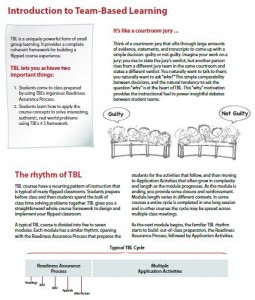Here are a few Team-Based Learning (TBL) resources and ideas for the New Year.
Want to know more about team-based learning? Are you using team-based learning and want a quick way to explain it to students and colleagues? Jim Sibley has drafted a brief explanation of the elements of team-based learning. (Download the PDF.)
Looking for a longer guide to TBL course design? Sibley’s Getting Started with Team-Based Learning (written with Peter Ostafichuk and other collaborators, published in 2014) walks the reader through designing a class for TBL, including explanations and rationales for each of the stages of team-based learning. I liked the many compelling examples and stories from long-time TBL practitioners. The book is full of great ideas helpful both to those just starting out with TBL, as well as people who would like to improve their current TBL courses. Get a preview by reading an excerpt on application activities (downloads a Word DOC). Learn even more by visiting the website.

Have a specific question about TBL? Search the TBL listserv for ideas and discussions, and browse the Team-Based Learning website. Here are two recent tips for the listserv.
- If you are currently using TBL in a large class, you may have tried a variety of methods to have your teams simultaneously report their specific choice (that’s 2 of the 4 Ss for effective application activities). Jim Sibley shared a video on the TBL listserv showing how he uses Google Forms to collect responses from the teams in his large class. This method allows the instructor to unveil the responses simultaneously when all of the teams have reported; each response has a time-stamp, useful if you’d like to call on the last team to respond to explain their answer.
- Interested in using an online peer evaluation system? The listserv also recently hosted a discussion of these system, as this time-consuming aspect of TBL may be accomplished more expediently using online software.
Duke faculty often create their own peer evaluation system using Qualtrics, but manage distribution of the scores and comments manually. If you are happy with your way of managing peer evaluations, please contribute to the TBL listserv or comment below.


